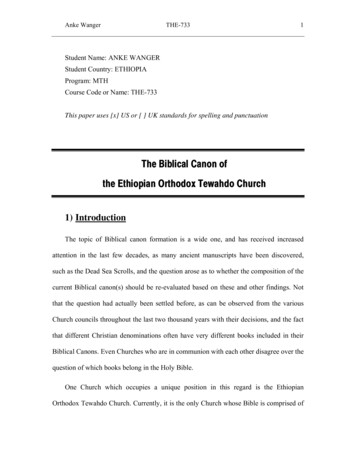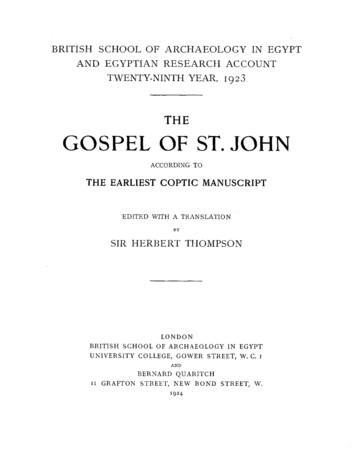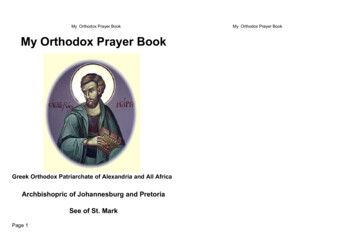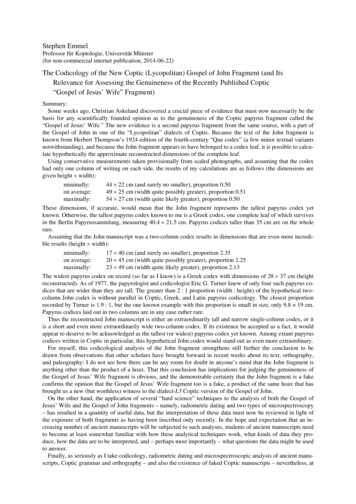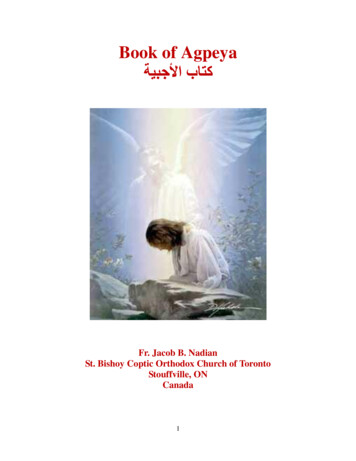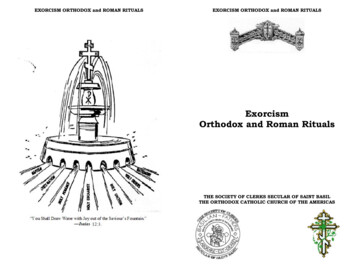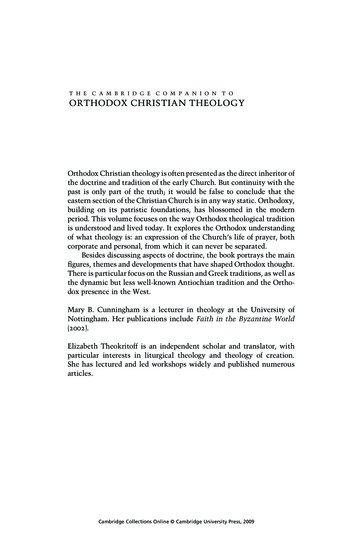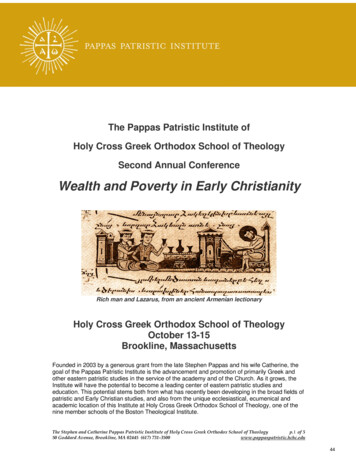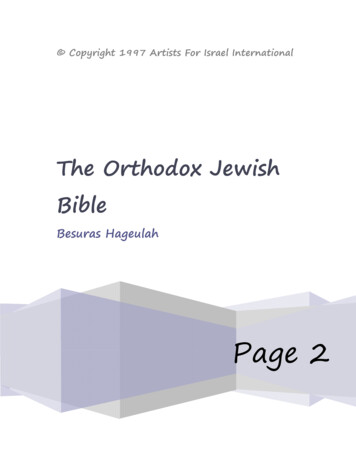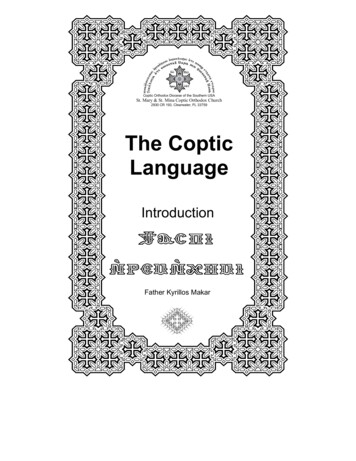
Transcription
Coptic Orthodox Diocese of the Southern USASt. Mary & St. Mina Coptic Orthodox Church2930 CR 193, Clearwater, FL 33759The CopticLanguageIntroductionFather Kyrillos Makar
Notes1. The Coptic language is described by Professor Rodolphe Kasserof the University of Geneva, Switzerland as "one of the mostbeautiful, most cleverly structured and mostmusical in the world" *2. These lessons are designed to teach some introductory basicprinciples of the "Bohairic" Coptic Dialect which is used by the churchin its liturgical services.3. The pronunciation is the traditional pronunciation that is used bythe Church as well as the few families who use Coptic as their dailylanguage.4. There are 32 letters in the Coptic alphabet. The first 25 are derivedfrom the Greek letters that have their origin in the EgyptianHieroglyphic script, the last 7 letters are directly derived from theEgyptian Demotic Script.* Kasser, R., The Coptic Language(s), The Coptic Encyclopedia, Vol. 8, Atiya,A.S., ed., Macmillan Publishing Co., NY, 1991, Page 145.
LECTURE # 1The Egyptian Alphabets;Their relationship to other alphabetsEgyptian Contributions to the development of civilization:The contributions to civilization made by Egypt are best described byDr. Leonard H. Lesko who wrote1: "The ancient Egyptians madeoutstanding contributions to the development of civilization. They createdthe world's first national government, basic forms of arithmetic, and a 365day calendar. They invented a form of picture writing called Hieroglyphics.They also invented papyrus, a paperlike writing material made from thestems of papyrus plants. The Egyptians developed one of the first religionsto emphasize life after death. They built great cities in which many skilledarchitects, doctors, engineers, painters, and sculptors worked. The bestknown achievements of ancient Egypt, however, are the pyramids they builtas tombs for their rulers. The most famous pyramids stand at Giza. Thesegigantic stone structures - marvels of architecture and engineering skills have been preserved by the dry climate for about 4500 years. They serveas spectacular reminders of the glory of ancient Egypt."The rapid development of their writing system was facilitated by theirdiscovery of methods to make paper and ink. Walter A. Fairservis, Jr.2states that "One of the most important contributions made by ancient Egyptwas papermaking. Paper was made from the papyrus plant that growsabundantly in the marches of the Nile Valley.Before the Egyptiansinvented paper, writing was done on clay tablets, which crumble, or onstone, which is heavy and hard to carve. Unlike the rest of the ancientworld, the Egyptians required only a brush and some ink, and they couldeasily carry these materials anywhere they went." Donald Jackson alsoaffirms3 that "Indeed the marriage of liquid ink, pen and paper first broughtabout by the Egyptians was such a revolutionary step that it is still thefundamental basis of most handwritten communication today."Egyptian Alphabets as the Ultimate Source of the Modern WesternAlphabet:The Egyptians developed the Hieroglyphic Writing around 3000 BC4.It consisted originally of signs that stood for words or ideas, but graduallyeach sign stood for a syllable or a sound. Hieratic, which is a simplifiedcursive form of the hieroglyphic, was soon developed by Egyptian scribeswho used it for both religious and nonreligious purposes5. Around 700 BC
Demotic writing was developed. This was simpler and faster to write thanthe hieratic. The scribes used it for correspondence and record keeping5.Around 1500 BC, the Semites developed an alphabet which is basedon the Egyptian hieroglyphic system4,6,7. The Phoenicians, one of theSemitic peoples perfected an alphabet around 1000 BC. The Greekalphabet, which is the progenitor of Roman (Latin) letters4,6 was directlyderived from the Phoenician alphabet4,6,7,8, The Greeks not only took theforms of letters, they also took over some Phoenician names for the letters.The first letter of the Phoenician alphabet, , its name is aleph, meaningox, became , or alpha in Greek. The second letter, , or beth, meaninghouse, became , or beta in Greek4.Based on the above-mentioned facts, the English alphabet of todaycan be traced back to the sign writing of ancient Egypt. Barbara Mertzstates that: "The birds and the bees of the ancient Egyptian script mayhave a more direct relationship to our own alphabet than we realize9".Davies10 cites a quote by Gardiner describing this observation: "Thehieroglyphs lives on though in transmuted form within our own alphabet".Compton's Encyclopedia6 states that: "The Latin Alphabet is a developmentfrom the Greek alphabet. The Greek alphabet, in turn, is an adaptation of awriting system which was developed among the Semites of Syria about1500 BC. Outwardly, this first Semite writing seems to be an original andindividual creation. Its principals however, are certainly based on theEgyptian word-syllabic writing". Marianne Cooley4 states that "The Englishalphabetdevelopedfrom a number of early writing systems,beginning with the sign writing of Ancient Egypt". In the same reference4,she shows, in a table form, the development of each letter starting withthe Egyptian (about 3000 BC) followed by Semitic (1500 BC) followed byPhoenician (about 1000 BC) followed by Greek (about 600 BC) followed byRoman (114 AD) and finally the modern alphabet. Paul Johnson, in hisbook The Civilization of Ancient Egypt11, succinctly summarizes thedevelopment of modern Western Alphabet from the ancient EgyptianAlphabet in the following: "The Egyptians mined at this Sinai site (theancient turquoise mines) both during the Middle Kingdom and the NewKingdom. During the reign of Ammenemes III, around 1800 BC, Semiticworkers were used at this site. One of them, evidently a man of creativeingenuity, became familiar with Egyptian hieroglyphic writing anddetermined to adapt it to his native Canaanite language, then unwritten.His stroke of genius was to select the alphabetic signs from thehieroglyphs, rejecting the consonantal groups and the ideograms. The newscript survived and gradually spread north through Palestine and Syria,acquiring cursive characteristics in the process. In northern Syria, near theancient port of Ras Shamra, it took on a cuneiform style - that is, it wasadapted to the writing materials of the area, tablets and stylus. This Ras
Shamra script, ancient Ugaritic, has no other connection with Sumerian orBabylonian cuneiform. It is merely a modified form of the CanaaniteEgyptian alphabetic script. It was gradually adopted by the entire region, invarious forms, and above all by the Phoenicians, who had an alphabet oftwenty-eight letters. In the ninth century BC, the Greeks took over thePhoenician alphabet more or less as they found it, retaining even thenames of the letters. They reversed the direction of the script from right-toleft to left-to-right, but the really important change they introduced, madeessential by the structure of their own non-semitic tongue, was the vowelsign. They switched the signs for six Canaanite consonants not used inGreek to vowels, and thus gave the world the structure of the alphabetmore or less as we have it today. The ultimate source of the Westernalphabet, therefore, is ancient Egypt"11.The Microsoft Encarta 96 Encyclopedia12 traces back the origin of severalEnglish letters to their hieroglyphic origin. For example, the letter "A" istraced back to the Egyptian hieroglyph of an eagle, the letter "B" from thehieroglyph for "crane", etc.The Development of the Coptic Alphabet:A. The origin of the word "Coptic":The words "Copt, Coptic" as well as the words "Egypt, Egyptian" havethe same origin; and that is the old Egyptian words describing Egypt as "EKA-Ptah" meaning the House of the Spirit of Ptah. ( E means House; Kameans Spirit; and Ptah is one of the famous Gods of Old Egypt).Therefore, the words "Coptic" and "Egyptian" are linguistically one and thesame word.B. The origin of the Coptic Alphabet:The present 32 letters of the Coptic Alphabet are derived from twosources; The first 25 letters are modified from the Greek alphabet (table 1);it should be remembered that the origin of these Greek letters can betraced back to the old Egyptian letters4. whereas the last 7 letters are amodification from Demotic letters (table 2)13.C. The contribution of the Coptic Alphabet to the Russian Alphabets:The current Alphabet of the Russian Language is known as the CyrillicAlphabet. It was invented by Saint Cyril (826 - 869 AD) and SaintMethodius (815 - 884 AD), two Greek brothers who were missionaries toRussia during the 9th Century. They knew Coptic and they introduced,along with the Greek letters, Coptic letters such as (written as ) into theRussian Alphabet that is still in use in Russia today 14 .D. The Greek words in the Coptic Liturgy and the Coptic Language ingeneral:
In the first few centuries of Christianity in Egypt, the Greek languagewas the cultural language of the world, in much the same way as theEnglish language these days. Greek was always the language used ininternational councils (Ecumenical councils). Many of the Coptic Churchfathers e.g. Saint Athanasius, our 20th Pope, wrote mainly in Greekbecause, at that time, this is how people everywhere in the world wouldunderstand. However, many other Church fathers wrote in Coptic. ManyEgyptians, especially in Alexandria, spoke Greek very fluently, in additionto Egyptian (Coptic) their mother tongue.When Saint Mark came to Egypt and started his ministry there, Greekwas the language that Saint Mark used and it was the language of theLiturgy that He handed down to his successors. When the Liturgy was latertranslated from Greek to Egyptian (Coptic), the Church kept some Greekwords and expressions, and the Copts were very familiar with the meaningof these words. However, it is very important to remember that over 90%of the Divine Liturgy service and the Praisesis in Egyptian (Coptic),and less than 10% is in Greek.The following are few examples of words of Greek origin that areused in our Liturgy:1. Words of Greek origin that are used by the Coptic Church and manyother churches. Actually these words are now part of many languages,including the Coptic as well as the English aconCatholicOrthodox
2. Greek words that are sometimes used but have Coptic equivalentsGreek ptic Equivalentv nou]macnou]v/eyouaby/eyouabs l/laftwnfqen -owab)(Eshleel)(aftonf)(khen oumethmee)MeaningGodMother of GodSaint (masculine)Saint (feminine)Prayeris risenTruly3. Traditionally, there are few hymns that are usually sung in Greek,doxa patri(Thoksa Patri)agioc oyeoc(Agyos o-The-os), rictoc anect/(Ekhristos Anestee)But the majority of Church hymns are in Coptic e.g.qen v ran(Khen-efran)p ouro(Ep-ouro)taisouri(Tai-shouri)It should be remembered that the Coptic Language represents thefinal development of the Egyptian language. Cyrus Gordon, in his book,"Forgotten Scripts", states that: "The Coptic Church still preserves thenative Egyptian language written in Greek characters, so that we have anunbroken tradition of Egyptian texts spanning about five thousand years"15.As a matter of fact, the Coptic language was the real key to the decipheringof the hieroglyphic and Demotic scripts by Champollion16, 17. As a Frenchteenager living in Grenoble, France, Champollion dreamed of being the onewho would unlock the secrets of the Rosetta stone. He studied bothancient History and Coptic language. Christine Hobson in her book "TheWorld of the Pharaohs" 18 describes Champollion as "A genius with a gift oflanguages, including Coptic which he mastered early, believing correctly,that it would be the key he would need one day to understand Egyptian".Later on, he used his knowledge of the Coptic language to decipher thehieroglyphic writings on Rosetta stone.This great accomplishment ofChampollion widely opened the doors to the unlocking of the gloriousmysteries of Pharaonic Egypt15, 16, 17.The importance of the Egyptian (Coptic) language.
1. It represents the final stage of the development of the Egyptian tongue,and in the words of Cyrus Gordon15, we have "an unbroken tradition ofEgyptian texts spanning about 5000 years". Coptic language was thespoken language in Egypt until the 11th Century when it was graduallyreplaced by Arabic. There are some historical records indicating that it wasstill the spoken language in some areas of Upper Egypt until the 17thcentury 19.2. It was the language that Jesus - as a baby visiting Egypt with Saint Maryand Saint Joseph - heard and spoke. Egypt was the only country Jesusvisited outside his home country. Therefore, we feel that our old countryand our language were blessed through this visit.3. Although the Coptic language, at the present time, is no longer used bysignificant number of Egyptians, it still lives on in the hundreds of words inthe Egyptian Arabic dialect spoken everyday in Egypt 20.4. The Bible was translated to the Coptic language around the secondcentury by the Egyptian scholars of the theological School of Alexandria,who were very fluent in both Greek and Coptic. Therefore the Coptictranslation is considered one of the most reliable and accurate translationsavailable.5. The original writings of several early Church fathers were in Coptic, e.g.the writings and teachings of Saint Antony, the first Christian monk in theworld, and those of Saint Shenouda the archmandrite were all in the Copticlanguage21.
Bibliography1. Lesko, Leonard H., The World Book Encyclopedia, Vol. 6,World Book Inc., Chicago, 1991, Page 133.2. Fairservis, Walter A. Jr., Egypt; Gift of the Nile,The Macmillan Company, New York, 1963, Pages 74 - 75.3. Jackson, Donald, The Story of Writing,Taplinger Publ. Co., Inc., New York 1981, Pages 19 - 20.4. Cooley, Marianne, The World Book Encyclopedia, Vol. 1,.World Book Inc., Chicago, 1991, Pages 382 - 383.5. Snyder, John W., The World Book Encyclopedia, Vol. 1,World Book Inc., Chicago, 1991, Pages 228 - 229.6. Compton's Encyclopedia, Vol. 2. E. F. Compton Company(Division of Encyclopedia Britannica), Helen HemingwayBenton, Publisher, 1974, Page 284.7. Gelb, I.J. and Whiting, R.M., Academic American Encyclopedia,Vol. 20, Grolier Inc., Danby, Connecticut,1992, Page 293.8. Reference 3, Page 26.9. Mertz, Barbara, Temples, Tombs and Hieroglyphs: A History of AncientEgypt., Dodd, Mead & Company, New York, 1978, Page 258.10. Davies, W.V. Egyptian Hieroglyphs, University of California Press,Berkley and Los Angeles, California 1987, Page 60.11. Johnson, Paul, The Civilization of Ancient Egypt, Atheneum, New York,1978, Pages 164 - 165.12. Microsoft Encarta 96 Encyclopedia. 1993 - 1995 MicrosoftCorporation; Funk & Wagnalls Corporation.13. "A Reference Book in the Grammer of the Coptic Language",(Arabic Reference) Publications of the Society of Saint Minathe Miracle-Maker, Alexandria, Egypt, 1969, Page 18.
14. Reference 13, Page 34.15. Gordon, Cyrus H., Forgotten Scripts: Their Ongoin Discoveryand Decipherment, Dorset Press, New York, 1987, Page 23.16. Reference 5, Pages 229 - 230.17. Reference 13, Pages 34 - 35.18. Hobson, Christine, The World of the Pharaohs, Thames andHudson Inc., New York, 1991, Page 157.19. Bishop Yoannis, The History of the Coptic Church followingthe Council of Chalcedon, El Ra-ed Publication Corporation,Staten Island, NY 1989.(Arabic Ref.), Pages 48 - 50.20. Guirguis, Pisenti Rizkallah, Coptic Words in the spokenArabic Dialect (of Egypt), Quased Kheir Publication Co.,Cairo, Egypt, 1975, Pages 1 - 115.(Arabic Reference)21. Reference 13, Pages 27 - 28
Table 1The 25 Coptic Letters adapted from Greek silonFeiKeiEpseeOOGreekCapSmallABGDE Z?YIKLMNXOPRCTUV βΒBetaγΓGammaδ DeltaεΕEpsilonNot used as a Greek �, ΩOmegaNote that most Coptic letters are written in a somewhat differentway than the corresponding Greek Letters.Note also that the Coptic names of the letters are in many cases different from the Greek names
Table 3. Summary of theNames and Pronunciation of the Coptic onunciationABGDE Z?YIKLMNXOPRCTUV "WSFQHJ{} abgde6z/yiklmnxoprctuv,'wsfqhj[]AV, BG, N, GHTH, DEZEETHI,YKLMNXO (Short)PRS, ZTV, I, OFK, SH, KHPSO(Long)SHFKHHJ, GCHTEEas in father , or as in fanbased on position in the wordbased on position in the wordTH as in then,(D in names)as in pen, or as rainit is the numeral 6as in zebraas in meetas in thinkbased on position in the wordas in cookas in lookas in motheras in nancyas in boxas in British notas in Peteras in roombased on position in the wordas in takebased on position in the wordas in fanbased on position in the wordboth p and s are pronouncedas in throwas in shakeas in fanas in Arabic Khas in housebased on position in the wordas in Churchas in teaMakes the letter a Separate syllable
Figure 1A flow chart showing the developmentof several alphabets fromthe Egyptian Hieroglyphic Script
1. Consonant Lettersn (n)t (t)k (k)f (f)r (r)h (h)z (z)j (g or J)2. Vowel Soundsa (a)e (ai)/ (ee) o (o)ou (ou)Jinkimi (i)w (oo)A little slash on top of letters to makethem pronounced as "separate syllables".
1. Consonant LettersLetterNamenNeiN(as in No)fFayF(as in Fish)rRoR(as in Room)tTavT(as in Take)hHoriH(as in House)K(as in cook)Z(as in Zone)kzjKappaZeetaGangaPronunciationJG(as in Jim)If followed by e, i, /(as in Go)all other situations.How to write it
2. Vowel SoundsVowel (s)NameaAlphaeEyyiyota/oEetawAE(as in Rain)(or as in Pen)I(as in Did, King)OrYOOOPronunciation(as in Father)(or as in Fan)(as in yellow)if followed or precededby another vowelEE(as in Meet)Short O(as in not)Long O(as in Broad)(open long O)Long O(as in Broom)(closed long O)Note:When ou is followed by anothervowel, it is pronounced as if there isa w between theme.g. oua is pronounced owwaoui is pronounced owwiou/ is pronounced owweeouJinkimmakes separate syllable( n en)How to write it
Read and study the following words using the letters of Lesson 2WordnofriApprox. pronunciationin EnglishnofriHinanena-nai (as in rain)Gooda toouia-to-owwimorningrouhirouhieveningnane a toouina-nai a-to-owwiGood morningnane rouhina-nai rouhiGood eveninge hooue-ho-oodaye jwrhe-gorhnightnofri e hoounofri e-ho-ooGood Daynofri e jwrhnofri e-gorhGood Nightnainay (as in buy)have mercynannanupon usjejai (as in rain)Coptic conjunction articleje nai nanjai nay nanhave mercy upon usir/n/ereeneepeaceanz/banzeebschooliwtyoat (as in boat)fatherouohowwohandouaiowwayonef touef-toofourjoutgoottwentyjout f tougoot eftootwenty fouroujaioo-gayBy – So long(Greek word)Meaningor Good
Consonant Letters (cont.)l (l)p (p)s (sh)m (m)c (s/z)q (kh)] (ti)x (x)v (f)[ (ch)
Consonant Letters (cont.)LetterNamelmxLavlaL(as in Look)MeyyM(as in Mother)EkseeX(as in ax)PeeP(as in Pepper)pcSeemaPronunciationZS(as in Zone) (in words ofGreek origin whenfollowed by the letter M)(as in Same)In all other situations.vFeyyFsShaiSH(as in Shake)KhaiKh(as in German Achtung).q[](as in Fan)Cheema Ch (as in Church)TeeTee (as in Tea)How to write it
Read and study the following words using the letters of Lessons 2 & 3WordpaciApprox. pronunciationin Englishpassito allir/n/ paci (Gr. word)ereenee passipeace to alls l/leshleelprayajpagphourajpiaagpiaBook of the hourssaishay (as in buy)Feast, sunrisenofri sainofri shayhappy feastpeniwtpen-yoatour fathernofri peniwtnofri pen-yoatHi Abounanofri e jwrhnofri e-gorhGood Nightqenkhain (as in rain)in, by, throughv ranef-ranthe namev iwtef-yoatthe fatherqen v ran m v iwtkhain ef-ran em-efyoat In the name of the fathernemnaim (as in rain)and, withs/risheeriSonserishairi (as in rain)daughterconSon (as in British hot)brotherpaconpa-sonmy brothercwnisoani (as in boat)sistertacwnita-coanimy sisterc nauesnavtwosomtshomtthreeMeaning
1. Consonant Letters (cont.)b (b/v)g (g/n/gh) d (d/th), (k/sh/kh) ' (ps)y (th/t)u (v / i / "o")6 (The numeral 6 – is not a letter)2. Some grammatical notes
1. Some Consonant Letters (cont.)LetterbgNameVeetaPronunciationV (as in vase)when followed by a vowelB (as in baby)when it is the last letter ofthe wordNote:If followed by a consonant, it ispronounced B in most cases.- The following are examples ofwords where b is followed by aconsonant but pronounced Vabba (ava) Bishop's titletwbh (tovh) ask, prayebsi (evshi) slumbertebt (tevt) fishG (as in Go)if followed byGamma N (as in No)if followed bye, /, i, ug, k, x, ,in all other situationsdy'DeltaD (as in Do)in proper namesTh (as in this)in all other casesTheeta T (as in Take)csif preceded by ,Th (as in Think)in all other casesEpseePSHow to write it
Letter,NameKeyyPronunciationK (as cook)In all Coptic words (or inGreek words that borrowedinto the Coptic language)e.g. ,/mi (keemi) Egypt,w(ko)puteu,/ (evkee) ask, pray(sometimes pronounced evshee)'u,/ (psikee) soul(sometimes pronounced psishee)SH (as in Shake)in Greek words whenfollowed by e, /, i or ue.g. ,ere (shere) HailKH (as in German Achtung) inGreek words in othersituationse.g. pi, rictoc(pikhristos) ChristuEpsilon1. long o as in roomIf preceded by o(See Page 1 – 2)as in v nou] ,p ouro2. V as in Vase If precededby a or eas in Eua , Dauid3. i as in didin all other situations.as inhumnoc , marturoc6So-oThis is not a letter,It denotes the numeral 6.How to write it
Read and study the following words using the letters of Lessons 2, 3 & 4Word'almocApprox. pronunciationin Englishpsalm(Gr. word) psalmosdoxa(Gr. word)Meaningthoksa (as in them)glorythoksa patriglory to the fathermaumavmothertamauta-mavmy mothervai pe m/nafay (as in buy) pe mina This is minayai te mariathay te mariyyaThis is maryparyenocparthenosvirginpi, rictocpi-ekhristosChristaftwnfAf-tonfis risenqen oumeym/ikhain ou-methmeetrulyv nou]ef-nootiGodp [oicep-choysThe Lordp ouroep-ooroThe King]ourwti-ooroa (as in boat)The Queen,/mikeemiEgyptremn ,/miraim-en-keemiEgyptian (Coptic)remn a merikaraim-en-amerikaAmericanremn , los (as in go)angeldoxa patri(Gr.)(Gr. word)
Notes1. Coptic Definite articles(equivalent to "the" in English)3 for singular masculinepiv p pitotce.g. v iwte.g. p s/rie.g.the chairthe fatherthe son3 for singular feminine]y t ]paryenoce.g. y maye.g. t serie.g.the virginthe motherthe daughter2 for pluralninenniaggelocthe angelse.g. nens/ri m v nou] the sons of Gode.g.
2. How to say the numbers in Coptic1 oneowwayouai2 twoesnavc nau3 threeshomtsomt4 foureftoof tou5 fiveetyoot iou6 sixso-oocoou7 sevenshashfsasf8 eighteshmeens m/n9 ninepsit'it10 tenmeetm/t11 elevenmeet owwaym/t ouai12 twelvemeet esnavm/t c nau20 twentygootjout21 twenty one jout ouaigoot owway24 twenty four jout f tou goot eftoo30 thirtymapmap40 fortyehmai (as in rain)h me50 fiftytaivi (as in rain)tebi60 sixtysai (as in rain)ce70 seventyeshvai (as in rain)s be80 eightykhamnai (as in rain)qamne90 ninetypistavpictau100 hundredshai (as in rain)se1000 thousandshoso
Methodius (815 - 884 AD), two Greek brothers who were missionaries to Russia during the 9th Century. They knew Coptic and they introduced, along with the Greek letters, Coptic letters such as (written as ) into the Russian Alphabet that is still in use in Russia today 14. D. The Greek words
